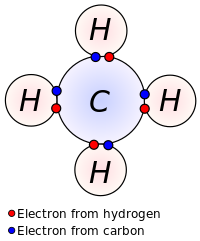
Photo from wikipedia
Abstract In the present theoretical study, experimental tuning of emission peaks in La@ C 82 (OH)n as a function of OH covering is explained through the arrangement of hydroxyl groups… Click to show full abstract
Abstract In the present theoretical study, experimental tuning of emission peaks in La@ C 82 (OH)n as a function of OH covering is explained through the arrangement of hydroxyl groups on fullerene surface. Up to 400 different configurations were taken into account to increase the coating in La@ C 82 (OH)n (n = 1, 2, 4, 8, 12, 13, 18, 24, 31, and 32). Additionally, descriptors from density functional theory are used to measure the electron-donator and electron-acceptor capacity of fullerenols, besides comparing the electron-acceptor capacity with C 60 , a molecule used in biomedicine and [6,6]-phenyl- C 61 -butyric acid methyl ester (P C 61 BM) a compound widely used as acceptor in the bulk heterojunction of organic solar cells. It was found that the highest coatings are the best electron-donors. On the other hand, it is important to mention that hydroxylated mono-endohedral metallofullerenes were found with better electron-accepting capacity than P C 61 BM which could have a good impact in organic solar cells performance.
Journal Title: Chemical Physics
Year Published: 2019
Link to full text (if available)
Share on Social Media: Sign Up to like & get
recommendations!